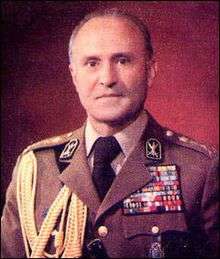Abbas Gharabaghi
Arteshbod Abbas Gharabaghi (Persian: عباس قرهباغی; 1 November 1918 – 14 October 2000) was the last chief of staff of the Iranian armed forces as well as deputy commander-in-chief of the Iranian Imperial Army during the rule of Mohammad Reza Pahlavi, the last Shah of Iran.
Abbas Gharabaghi | |
|---|---|
 | |
| Minister of Interior | |
| In office 27 August 1978 – 4 January 1979 | |
| Monarch | Mohammad Reza Pahlavi |
| Prime Minister | Jafar Sharif-Emami Gholam-Reza Azhari |
| Preceded by | Asadollah Nasre Esfahani |
| Succeeded by | Shapour Bakhtiar |
| Member of Regency Council | |
| In office 13 January 1979 – 22 January 1979 | |
| Appointed by | Mohammad Reza Pahlavi |
| Personal details | |
| Born | Abbas Gharabaghi November 1, 1918 Tabriz, Iran |
| Died | May 14, 2000 (aged 81) Paris, France |
| Nationality | Iranian |
| Alma mater | Officers' School |
| Profession | Military Officer |
| Military service | |
| Allegiance | Iran |
| Branch/service | Imperial Iranian Army |
| Years of service | 1938–1979 |
| Rank | |
| Unit | 22nd Infantry Regiment (Mounted) |
| Commands | Commander-in-Chiefs of the Iranian Armed Forces |

Career
Gharabaghi served as the gendarmerie commander until 1979.[1] He was appointed chief of staff of the Iranian armed forces on 7 January 1979. His role was to support the Shah until the Shah left Iran, and then to support the civilian government the Shah left behind led by Prime Minister Bakhtiar. However, after much strife on the streets of Tehran and elsewhere, on 11 February 1979 Gharabaghi, along with 22 other senior military leaders, withdrew support of Bakhtiar, thus tacitly supporting the revolutionary Islamic republic.[2][3]
Works
Gharabaghi published his account of the revolution in his books Haghayegh Darbareye Bohran-e Iran ("Facts About the Iran Crisis", 1983), and Che Shod Ke Chonan Shod? ("Why did it happen?", 1999).[4] It is said that his decision to declare the army's "neutrality" was the main reason for the final triumph of the Iranian Islamic Revolution which ended the monarchy.
In his first book, Gharabaghi expresses his strong support and loyalty to the Shah and paints a detailed picture of the chaos within the military ranks caused by the last government under the Shah which clearly holds Prime Minister Bakhtiar responsible for the downfall of the monarchy.[5] He justifies his decision to declare the army's "neutrality" as the only reasonable solution given the circumstances and in order to prevent further bloodshed and calls Bakhtiar a traitor.
Death
Gharabaghi died in Paris in 2000.[6]
References
- Roberts, Mark J. (January 1996). "Khomenei's incorporation of the Iranian military" (McNair Paper 48). National Defense University. Retrieved 31 July 2013.
- Bakhtiar Quits After Losing Army Backing The Guardian, 12 February 1979
- Memory Lane: Looking Back At The Road To Revolution The Iranian, 11 February 2001
- Why Did It Happen? Amazon
- Gharabaghi, Abbas (1983). Haghayegh Dar Bareye Bohran-e Iran. Sāzmān-i Chāp va Intishārāt-i Suhayl.
- The General's Widow The Iranian, 21 February 2001